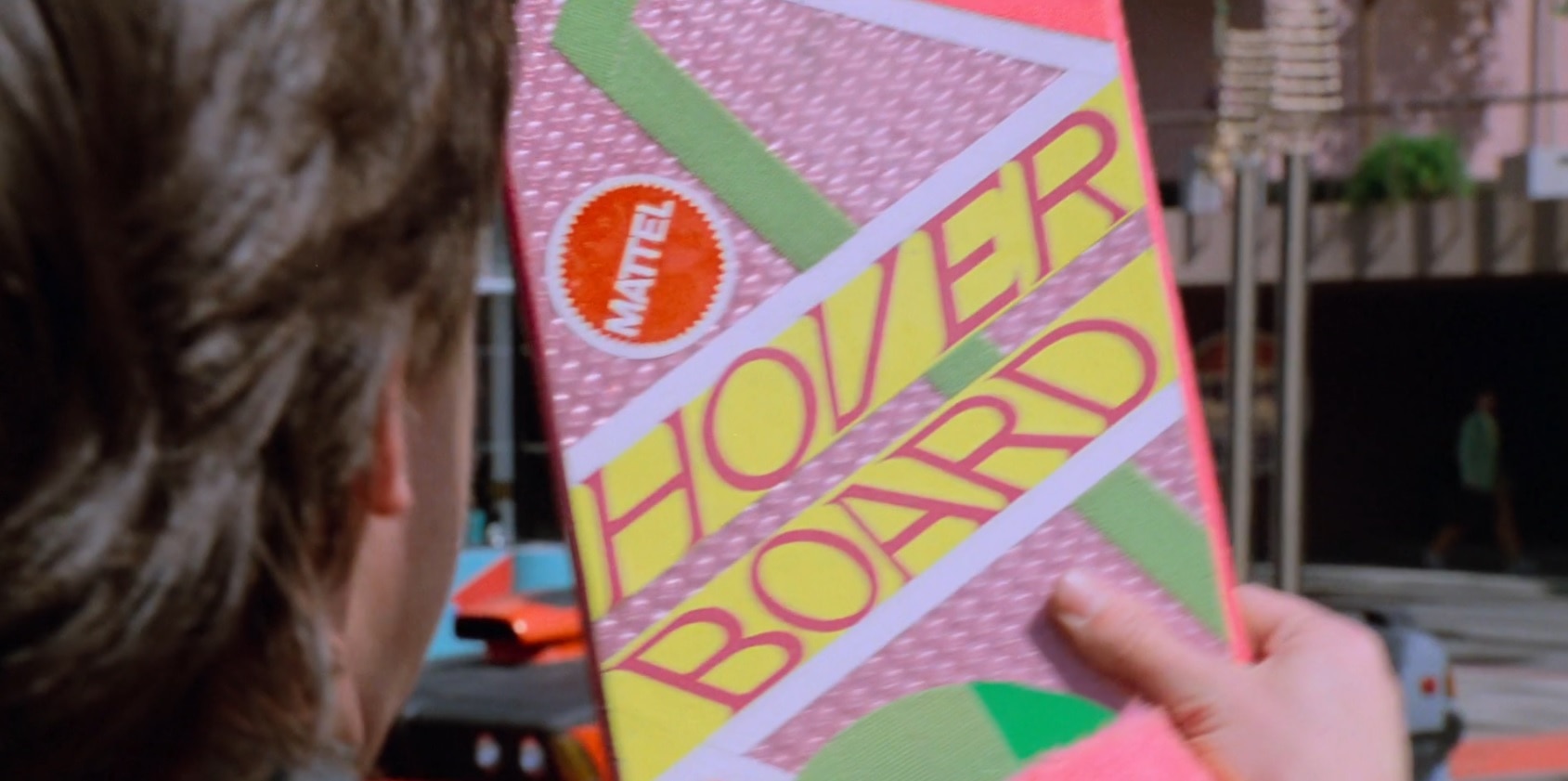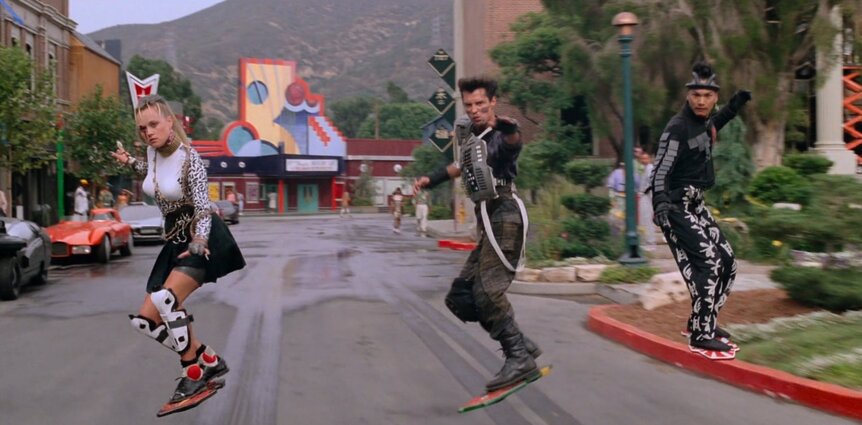Create a free profile to get unlimited access to exclusive videos, sweepstakes, and more!
C'mon, Marty! So how close are we to having real-life hoverboards like in Back to the Future Part II?
We've dreamed of it for decades, but how close are we to actually hovering off with Marty?

Back to the Future Part II helped define visions of the future in a way most other forward-facing sci-fi franchises just couldn’t. That was due in large part to the incredible, yet vaguely familiar feel of the technology presented in the flick. Alongside the spookily prescient vision of Biff as a powerful corporate overlord, were flying cars, magic pizzas, and the mode of transportation every ‘80s kind wanted: the hoverboard.
If you're looking to revisit that glorious future (and past), SYFY is running a Back to the Future marathon this Thurs., Oct. 21. Starting at 9:30 a.m. ET, we’ll be showing Back to the Future (1985), Back to the Future Part II (1989), and Back to Future Part III (1990) back-to-back until 12:30 a.m. the next morning.
Around the time of the movie’s release, rumors abounded in schoolyards all over the world that the hoverboards were, in fact, real. This was driven in part by a clearly apparent Mattel logo slapped on top of the board and more than a little wish-fulfillment from kids. Mostly it was driven by director Robert Zemeckis, himself. In a 30-minute special to promote the release of the movie, Zemeckis said “They’ve been around for years. It’s just that parents’ groups have not let the toy manufacturers make them. We got our hands on some and we put them in the movie.”
Sadly, 2015 came and went without the arrival of flying cars, Jaws 19, or hoverboards under Christmas trees, but not for lack of trying. Several companies have undertaken the task of bringing the dream of flying skateboards into reality.
The power problem
In the absence of true antigravity technology hoverboards need some source of energy to push them away from the ground. The force of gravity can be measured as acceleration. In essence, how quickly does an object fall toward the ground? There are, of course, other factors to consider. Wind resistance eventually matches that acceleration until you reach a terminal velocity, but experiments have proven that objects in a vacuum fall at a consistent rate regardless of their shape, size, or mass.
On Earth, that acceleration is approximately 32 feet per second, per second. If you fall for one second, you’re going 32 feet per second or about 22 miles per hour. If you fall for two seconds your speed doubles, three seconds it triples, and so on. Hovering requires balancing that downward pull with an equal and opposite force. This could be accomplished through large personal drones but that almost feels like cheating. It’s less like hovering and more like a low-flying helicopter. For the purposes of this discussion, we’re going to consider drones specialized aircrafts, not hovercrafts. When it comes to true hoverboards, the best solution may be powerful magnets and dedicated surfaces.
Any kid who ever played with magnets (and maybe ruined their childhood television set looking at the pretty colors) knows that two magnets in proximity either snap together or repel one another depending on their orientation. The force between magnets (or electromagnets) can be sufficient to counteract the pull of gravity. You’ve likely seen it work in a number of desk toys like floating globes. It’s also how maglev trains work.
Hendo, a company specializing in hover technology, used this same philosophy to craft their hoverboard. The Hendo hoverboard has four electromagnets beneath the board itself, which the company calls hover engines. The four engines help to balance the field and keep the board stable. The only trouble is it requires a particular surface not readily available in the outside world, at least in quantities sufficient to cruise around on.
In order for the Hendo hoverboard to work, it has to be placed above a copper surface, or some other surface with similar properties, like aluminum. Counterintuitively, it works precisely because copper is not magnetic. Instead, copper is an inductor which interacts with powerful magnets by generating an electric field.
This interaction is described by Lenz’s law, named for physicist Emil Lenz, which states that an electric current induced by a magnetic field is opposed to the change in flux. In simpler terms, as a magnet moves in relation to a material like copper, a field is created which pushes against the direction of that movement. This can easily be seen by dropping a powerful magnet through a copper pipe. You’ll see that the magnet falls through the pipe much more slowly than it would ordinarily. That’s because, as the magnet moves in relation to the pipe, an opposing field pushes against the magnet in the opposite direction of its travel. The interaction isn’t powerful enough to stop the magnet from moving altogether, but it does slow it down considerably. Voila, under the right conditions magnets and copper create a repulsive force strong enough to combat the force of gravity.
This same relationship is also how much of the world’s electricity is generated. The force which slows the magnet through the copper tube is electric current and that current can be maintained so long as the magnets or the copper is in motion. Turning turbines, powered by wind, water, or other means create the motion, and the electric current is captured. It’s an experiment you can do at home by creating a copper cylinder made of spiraled wire. As long as the wire circles back on itself it will create a circuit. A light attached to that circuit will light up as a magnet falls through it.
In the case of hoverboards, the magnetic field created by the powerful electromagnets above a copper surface is sufficient to prevent it from falling. More than that, by altering the field of one or more of the electromagnets, Hendo was able to create force in a direction perpendicular to the surface, allowing control of movement forward, backward, and side to side.
Of course, the outside world isn’t paved with copper surfaces. The Hendo hoverboard, and other devices like it, can only work in specially crafted locales with the appropriately reactive surfaces. Devices like these can’t work on sidewalks, or over land or water. They could, however, enjoy success at dedicated spaces like hover rinks or hover parks.
With any luck, the future might include themed nights, black lights, neon colors, and hover skating to retro tunes. We may be able to recreate that glorious future of our imaginations. Now we just need to convince those lousy parent’s groups.



























